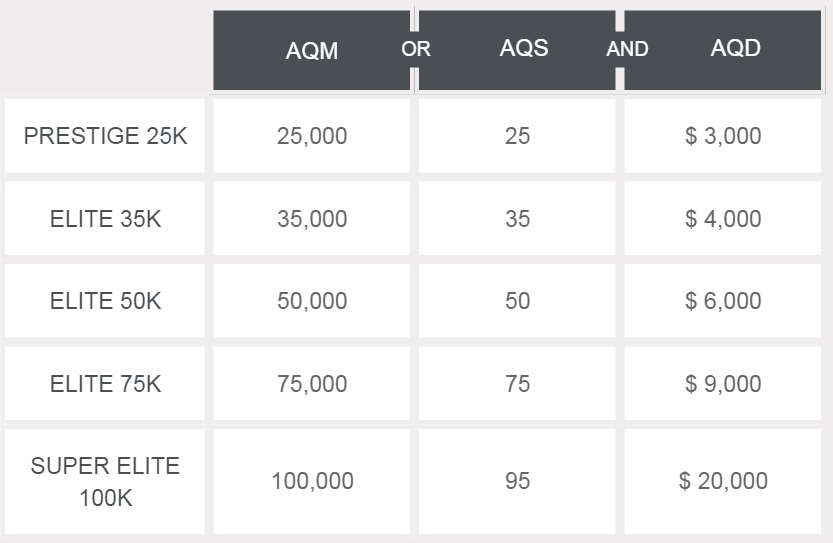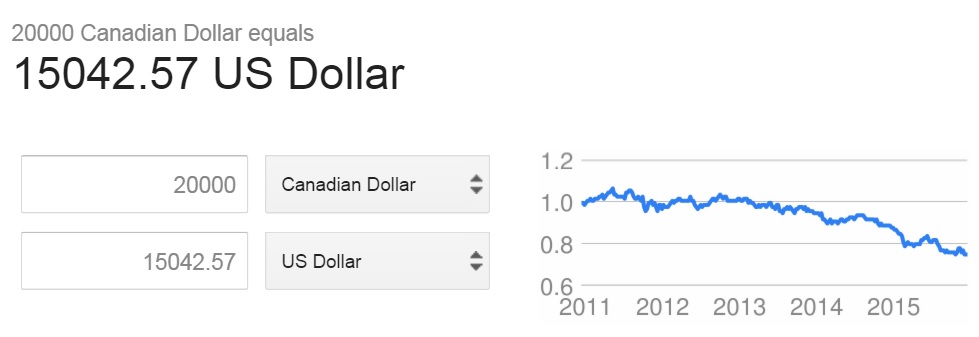Three years ago Delta introduced minimum spending requirements for elite status. The revenue requirement was essentially set at 10 cents per mile — e.g. $2500 for 25,000 mile status, $5000 for 50,000 mile status and so on. That was a big conceptual move, but one with limited effect in practice.
- At current ticket prices, it’s hard to spend less than 10 cents a mile on average for tickets.
- They allowed members to spend $25,000 in a year on their co-brand credit cards to buy out of the requirement.
- It didn’t apply to members with registered addresses outside the US
A year ago Delta raised their minimum spend for status by 20% to 12 cents a mile a year ago.
United followed Delta with a 2013 announcement and then announced increased spend requirements just a month after Delta did.
American AAdvantage on the other hand announced program changes that do not include minimum spend to qualify for elite status (no matter what Dallas news anchors think).
Air Canada’s Aeroplan has taken the plunge, though. Which means that it’s spreading… (HT: The Gate)

Unlike Delta which lets you avoid spend requirements by living abroad or spending on their co-brand card, and unlike United which lets you avoid spend requirements for status up to Platinum those same ways, Aeroplan will not let members avoid the revenue minimums. One Mile at a Time points out that they are removing the 4 Air Canada flight minimum rule for earning their elite status.
As with other carriers taking a similar approach, only their own flights or ticket stock qualify. Technological limitations generally prevent an airline from seeing the revenue attached to segments they neither sold nor flew but which are credited to their loyalty program. They warn as well that they won’t see the revenue figures attached to some bulk fares.

What’s interesting about Air Canada’s move is that they’re setting revenue requirements for the 25,000; 35,000; 50,000; and 75,000 mile status levels at a minimum of ~ 12 Canadian cents per mile. United and Delta currently set their thresholds at 12 US cents per mile.
But Air Canada is setting their 100,000 mile status threshold at 20 Canadian cents per mile. At first blush that seems crazy and is clearly designed to thin their top tier ranks. As they’ve clearly said,
[W]e are not a charity. …It’s not a secret that we would prefer our customers sitting in the [business class] cabin to have paid for it.
And, as Delta has pointed out when everyone’s an elite flyer no one is. (That of course isn’t quite true, members compete for some benefits which are limited like first class upgrades while other benefits like waived bag fees are not competitive.)
Still, it’s not quite as out in left field a threshold as it might seem because the Canadian dollar is so weak. Delta’s top tier status requires US$15,000 in spend (though with fewer miles flown).

And of course there’s less full service airline competition in the Canadian market than there is in the U.S. Frequent flyers like to complain about industry consolidation here, but there’s still United and Delta and American on top of robust low cost carriers and Southwest, JetBlue, and Alaska. It’s far easier to consolidate flying with a single airline for Canadian travel than it is for US travel.


Aeroplan does not have a revenue requirement
It’s Air Canada Altitude that will get revenue based
Also I assume that residence outside of Canada will only need to fulfill 50% of the published requirement for revenue
They did the same last year with the minimum Air Canada miles flown
E25K Air canada minimum 12,500 mile
E35K Air canada minimum
17,500 mile
E50K Air canada minimum 25,000 mile
SE100K Air canada min.
50,000 mile
A couple of days after they announced this minimum Air canada mile last year they said it’s will be 50% of the published requirement for members outside canada.
Which is to say that they removed entirely now for next year and replaced it with the new AQD
Yup, certainly started a wave of fury on FT and MP. AC’s pruning the ranks at the very top, only interested in keeping those who actually spend $5K for a transAt biz ticket every month or two. When Aeroplan introduced elite tiers back in 1989/90, I was told by its then VP (today President of the independent AIMIA that runs AE, though these elite decisions are now AC’s domain, which is why it rebranded the elite program Altitude) that the top tier benefits were designed for those who do mostly international travel and cross the Atlantic or Pacific a couple of times a year. Its then mid-tier Elite/STARGold (at 35K EQMs) was tailored to domestic/transborder fliers with appropriate benefits. Looks as if AC has returned to that rationale, though its 75KElite is now that earlier 35KElite (and 35KElite has been upped to 50KElite). Most AE/AC elites figured AC’d stick with its already implement “revenue” model, giving 25% and 50% mileage (EQMs/RDMs) for discounted TANGO fares, and 100% and more to higher economy and business class fares. This, and last year’s minimum 50% flights on AC metal requirement, were in themselves pretty severe restrictions on hitting any tiers of elitedom.
I migrated from AE to UA/MP about a decade ago when changes that were thought of then as draconian, were introduced. Still flew AC domestically, but increasing moved transborder and international flights to UA, and achieved 1K and kept it even to today. But like many UA 1Ks, the merger and other changes to MP led to disaffection and I moved over to AA and have been ExecPlat for several years, and quite pleased with my treatment. And while that program’s changes introduced last week (officially) were disappointing but expected…at least they didn’t come with a minimum spend (though as a non-US resident I am exempt from UA’s spend requirements).
One last comment, about our dollar. Yes, it’s down considerably against the US dollar, but it is just as weak as every other currency in the world (save the UK£) which has all languished at between 20% and 30% below yours, since yours started to soar two years ago…after it was devalued before that. American commentators tend to criticize other countries when those currencies drop in value against the US dollar, but fail to recognize this is the primary reason, not government manipulation of their currencies. (Yes, I acknowledge the Chinese situation, where the RMB is pegged to the US$, but that too has a sound rationale, since it has raised the price of Chinese goods to those other countries whose currencies have dropped as the US$ rose.)
Moreover, while $CAD being weaker than the $USD would benefit someone who lives and earns their money in the US trying for SE100K, it is unclear how the new $20,000 CAD requirement would not be “not quite as out in left field a threshold as it might seem” for someone trying for the same status within Canada…
I’d argue that Qantas has tougher spend requirements for its Platinum One status. It requires 2700 status credits on Qantas marketed flights and an additional 900 status credits on Qantas, oneworld or Jetstar flights.
An average Qantas fare earns status credits at a rate of $9-10 per status credit, while better fares earn at a rate of $6-7 per status credit.
On oneworld flights one can cheaply earn status credits at a rate of $3-5 but $7-8 on typical fares.
Assuming your average Qantas fare earns status credits at a conservative $7, whilst oneworld fares earn you status credits at $4 each, you’re going to need to spend $18,900 (7 * 2700) on the Qantas fares alone and an additional $2800 on oneworld fares which comes to a total of AUD$21,700.
At current exchange rates that’s roughly USD$15,700.
Hi Gary,
I tried to book two award seats using aeroplan tonight. The website shows that it has technical difficulties. What’s the reason of it?
Best,
Jack